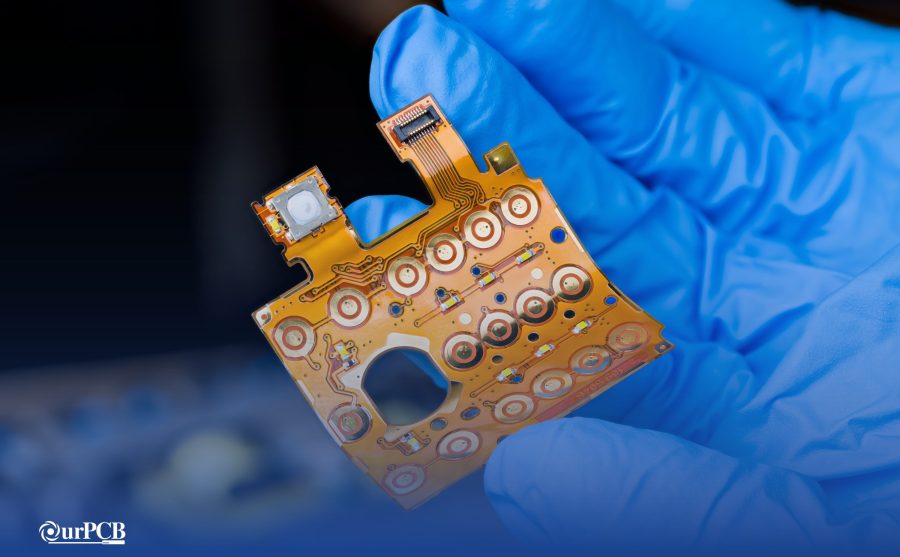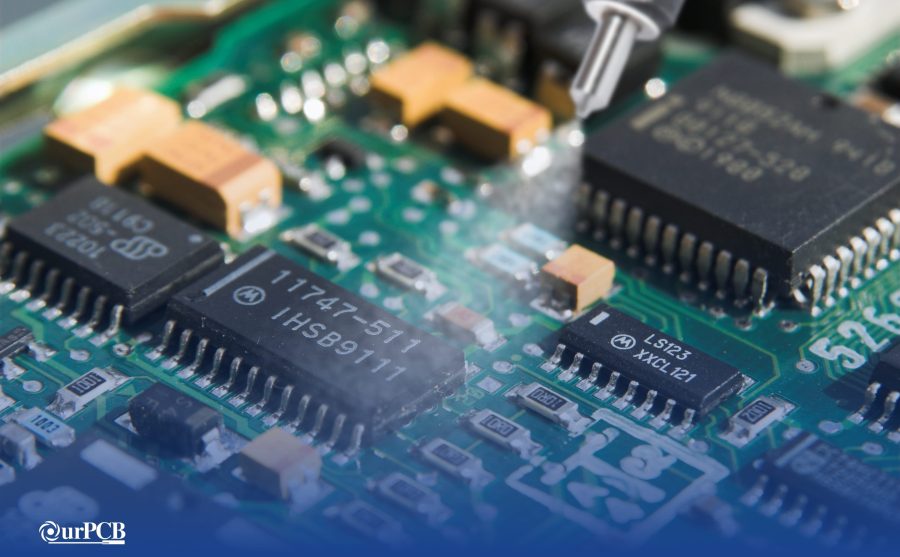SMT manufacturing is an integral part of the PCB assembly. You need to be extra careful during the process to make it successful. Otherwise, your PCB can develop various threats and problems.
One such threat is the development of solder balls during SMT manufacturing.
Solder balls can appear on a PCB due to various reasons. They can ruin the appearance of your electronics. Additionally, they can fall off and cause short circuits. As a result, your whole project or end product can fail.
In this post, we are going to explore the common causes of solder balls. We will also give you the solutions so that your SMT manufacturing becomes flawless.

(Quality control and assembly of SMT printed components)
Contents
- 1. PCB Has Moisture
- Measures:
- 2.Too Much Flux in Solder Paste
- 3. Improper Preheat Temperature
- Measures:
- 4. Problems in Solder Paste Printing
- Measures:
- 5. Missing Solder Mask Between Adjoining Pads
- Measures:
- 6. Improper Pad Spacing
- Measures:
- 7. Residues Left on PCB Surface and Pads
- Measures:
- 8. Issues with Stencil Dimensions
- Measures:
- 9. Misalignment of Solder Paste Printing or Components
- Measures:
- 10. Improper Placement Pressure
- Measures:
- 11. Solder Paste Oxidation
- Measures:
- Summary:
1. PCB Has Moisture
PCB can retain moisture for some causes. Sometimes, storage in humid conditions causes water retention. At other times, the preheat temperature is not hot enough. As a result, the flux doesn't dry properly.
Measures:
To avoid the problems, store PCB in dry conditions. Take care so that moisture and water don't damage the PCB. Also, bake the PCB at 120 C for at least 4 hours before SMT manufacturing.
The thickness of the PCB hole is also necessary. It should be enough to prevent the trapping of water.
Ultimately, be careful during the design phase. Use correct pad sizes and spaces.

(Alt- Bake PCB to remove moisture)
2.Too Much Flux in Solder Paste
Flux serves an essential function in SMT manufacturing. It eliminates oxidations of metals and cleans surfaces. You can also seal out air and further reduce oxidation. Moreover, flux improves the amalgamation for soldering.
Measures:
It would help if you were careful while using flux in your solder paste. Too much of it can lead to solder balls. You don't want that! Always use flux in the right quantity. Additionally, be sure to choose the proper flux for your application. Flux with lower activities often results in solder balls. So, the correct oxidation is a crucial aspect.
Also, use enough heat to melt the solder properly.

(Soldering Paste Solder Rod Cleaning)
3. Improper Preheat Temperature
It would help if you preheated your PCB before SMT manufacturing. The process reduces the thermal impact on the PCB. As a result, the solder paste will evaporate. If this doesn't happen, you can get solder balls on your PCB.
Measures:
There raise the temperature by 1.5 - 2 C from room temperature. Maintain it all the way to reach 150 C. Don't increase the preheat temperature rate too rapidly. That will lead to thermal damage.
A slow preheat rate will eliminate the risks of solder balls from your PCB. It also evenly spreads the solder paste. The flux can even successfully escape the solder paste.

(Alt- Preheat PCB slowly before SMT manufacturing)
4. Problems in Solder Paste Printing
Several issues during solder paste printing can lead to solder balls. The most common problems are due to stencils that are not clean. It leads the solder paste to attach to places and form solder balls.
Measures:
A clean stencil is a must for quality solder paste printing. Remove all contaminants and solder paste from the stencil before SMT manufacturing. Another issue is stencil sticking to PCB green masking. It happens when you have solder paste under the stencil.
To avoid this problem, set a zero gap between PCB and stencil for printing. Also, set the squeeze print pressure to a minimum.

(Cleaning solder paste on printed circuit board molds on SMT)
5. Missing Solder Mask Between Adjoining Pads
It is the simplest mistake in SMT manufacturing. The absence of a solder mask between adjacent pads can lead to solder balls. Any manufacturer will not want that!
Measures:
The solution to this simple problem is also straightforward. You need to apply the solder paste properly on the PCB. Make sure you don't miss out on areas like spaces between pads. Using quality equipment can reduce the chances of this problem.
It would help if you also used a slow preheat temperature rate. That will help spread the solder paste evenly on the PCB surface. It reduces the likelihood of creating gaps.

(Alt- Don't forget to apply solder mask between adjacent pads)
6. Improper Pad Spacing
Proper pad placement is crucial for SMT manufacturing success. Otherwise, it can lead to the failure of your project. Additionally, you also have the risks of solder balls. The solder balls can cause shorts or even fall off. For this reason, proper placing of pads is essential.
Measures:
You need to adopt caution during the design phase. Design the pads in a way to maintain the required gaps between one another. Using a PCB designing solution makes the job easier. You can program your weaknesses correctly and rule out possibilities of improper spacing.
The stencil opening should also match the PCB design. Otherwise, you will end up with solder paste at the wrong places.

(Surface mount device (SMD) electronic components on printed circuit board (PCB))
Special Offer: Get $100 off your order!
Email [email protected] to get started!
7. Residues Left on PCB Surface and Pads
PCB surfaces and pads may be dirty or contain residues. Often, you may find leftover flux on PCB or pillows after getting your batch. It can lead to many problems, including solder balls.
Measures:
It would help if you made it a point to clean your PCB. Manufacturers use industrial processes to remove all residues from PCB. Then they use the reflow soldering process. The process ensures you don't use any extra solder that can form residues.
Always check if your PCB is clean. If you find residues, clean them using professional solutions.

(Alt- Make sure your PCB is clean)
8. Issues with Stencil Dimensions
It would help if you used the right stencil for SMT manufacturing. The thickness of the stencil is of utmost importance. Stencils that are too thick can hamper soldering. It will also lead to the formation of solder balls.
Measures:
It would help if you chose the right stencil thickness. Consider your SMDs to select the right stencil width. Don't go for stencils that are too thick. Use relatively thin stencils.
Additionally, keep an eye on stencil opening ratios and shapes. Any discrepancy here can result in solder balls. So, make sure the stencil apertures ratios are accurate.

( SMD & IC mounted part on board)
9. Misalignment of Solder Paste Printing or Components
Successful SMT manufacturing needs the right alignment of solder paste and components. That's why we stressed so much on the above point. You should have proper stencil features to make your project a success. Also, make sure the stencil is aligned correctly with the board.
Measures:
How you place your components is also an important aspect. Any misalignment or wrong placement can hamper the project. You might even get solder balls in the process. So, always ensure the right features and alignment.

(Alt- Align your stencil properly during SMT manufacturing)
10. Improper Placement Pressure
The mounting pressure of your components decides how your PCB turns out. Use too much trouble, and the solder squeezes out from the sides of the pad. The solder then turns into solder balls during reflow soldering.
Measures:
Naturally, you need to set the right mounting pressure for your PCB. Determine the appropriate strength after assessing your components. Don't make the pressure too high. You should also adjust the power of the pick-and-place nozzles. Use enough pressure to just set the elements firmly on the PCB.

(Manual component installation)
11. Solder Paste Oxidation
Some solder pastes are vulnerable to oxidation. Water-soluble solder pastes mainly fall in this category. The solder paste can increase oxidation and result in solder balls.
Measures:
To avoid this problem, choose the right solder paste for SMT manufacturing. Store the solder paste in a cold place and follow handling guidelines.
Also, don't use old solder pastes. Discard them after they cross the expiry date. Additionally, don't mix old and new solder paste during SMT manufacturing.

(Alt- Use the right solder paste to avoid solder balls in your PCB)
Summary:
Following our tips will help you eliminate the risks of solder balls in your PCB. Your SMT manufacturing will be a success, and your products will sell like hotcakes. Always order your PCB from a reliable manufacturer to avoid any issues. OurPCB manufacture high-quality PCB meeting your specifications. Our strict quality control helps us create the best products at the best rates.
Contact us today to place an order for SMT manufacturing.
Special Offer: Get $100 off your order!
Email [email protected] to get started!





